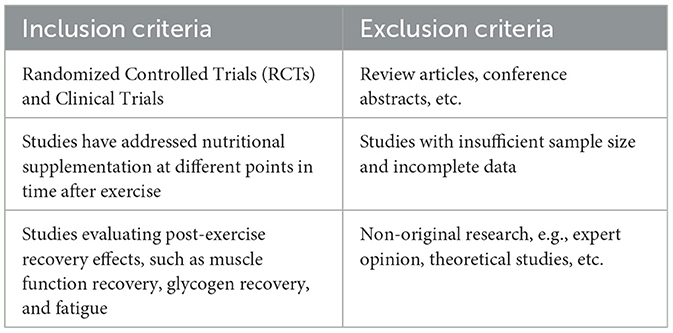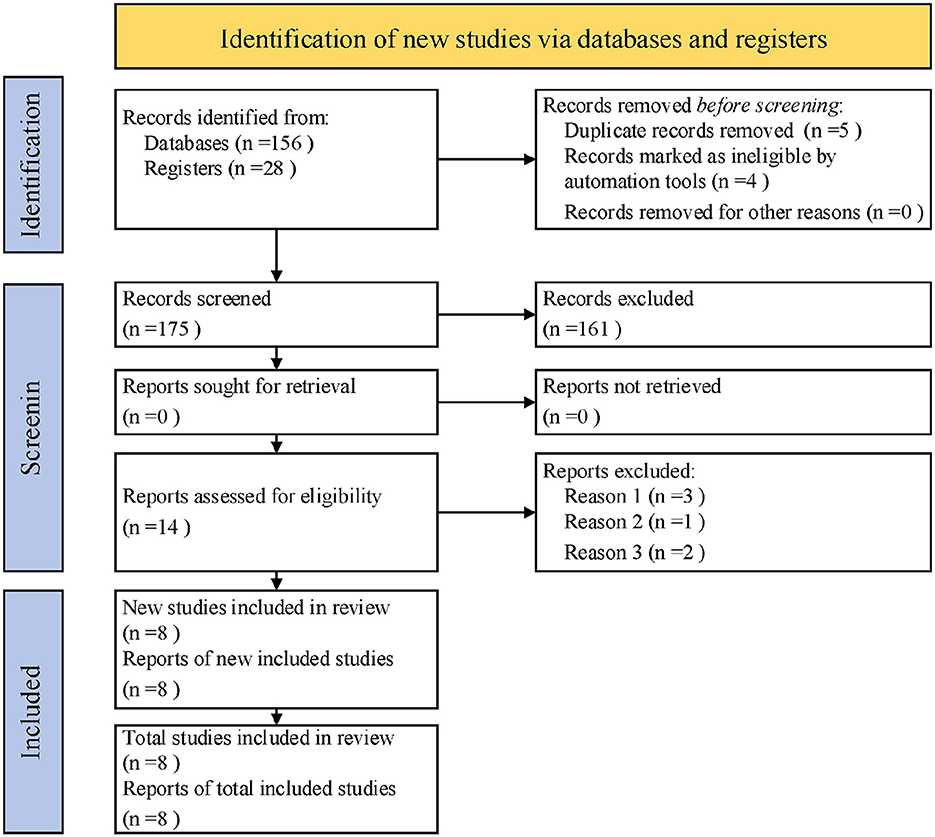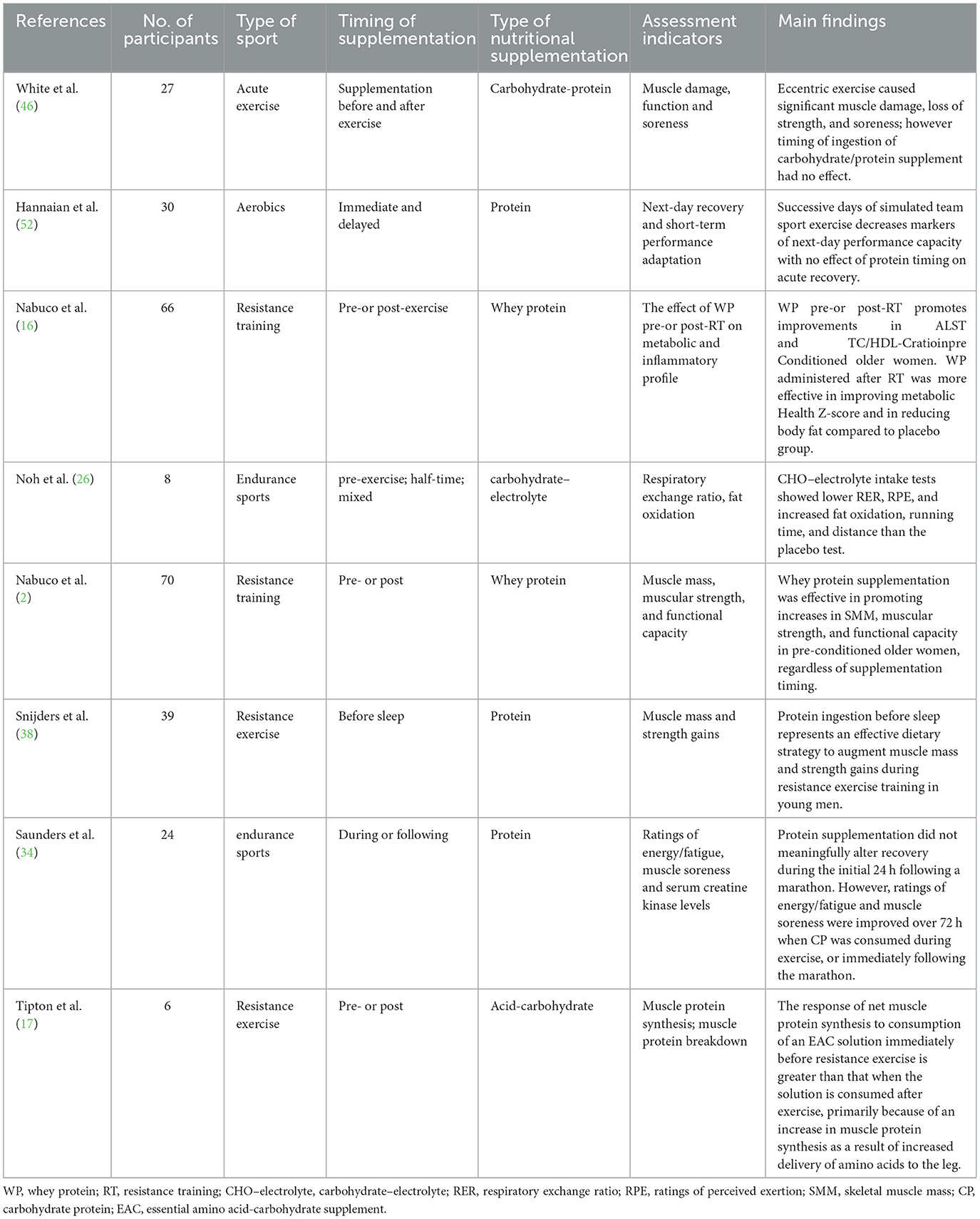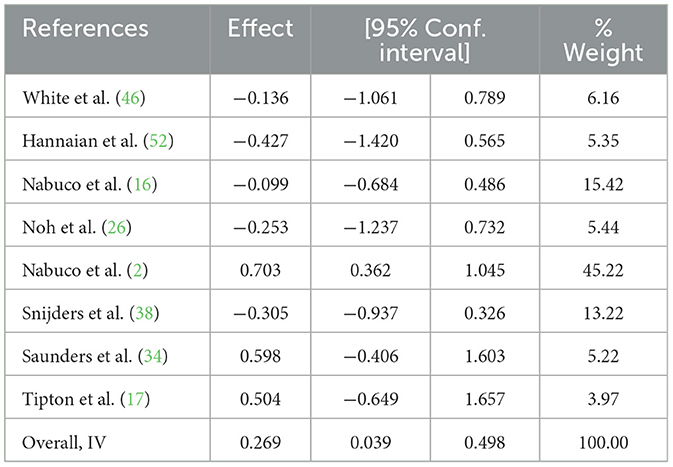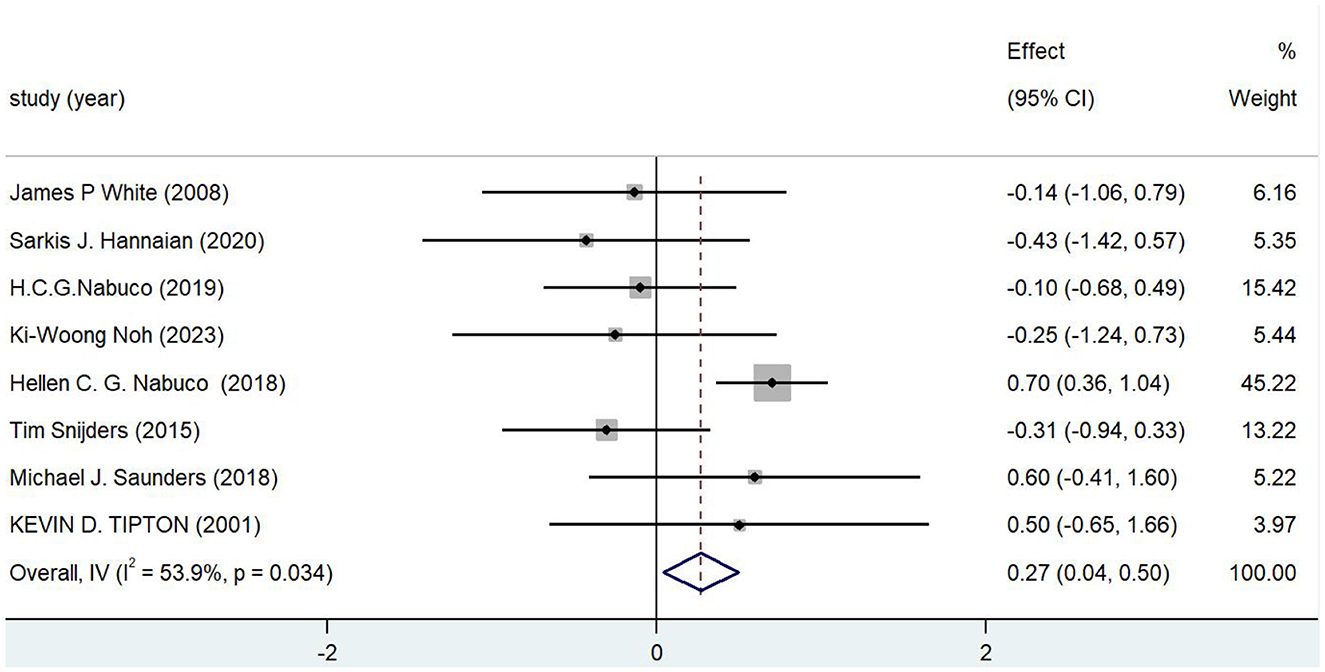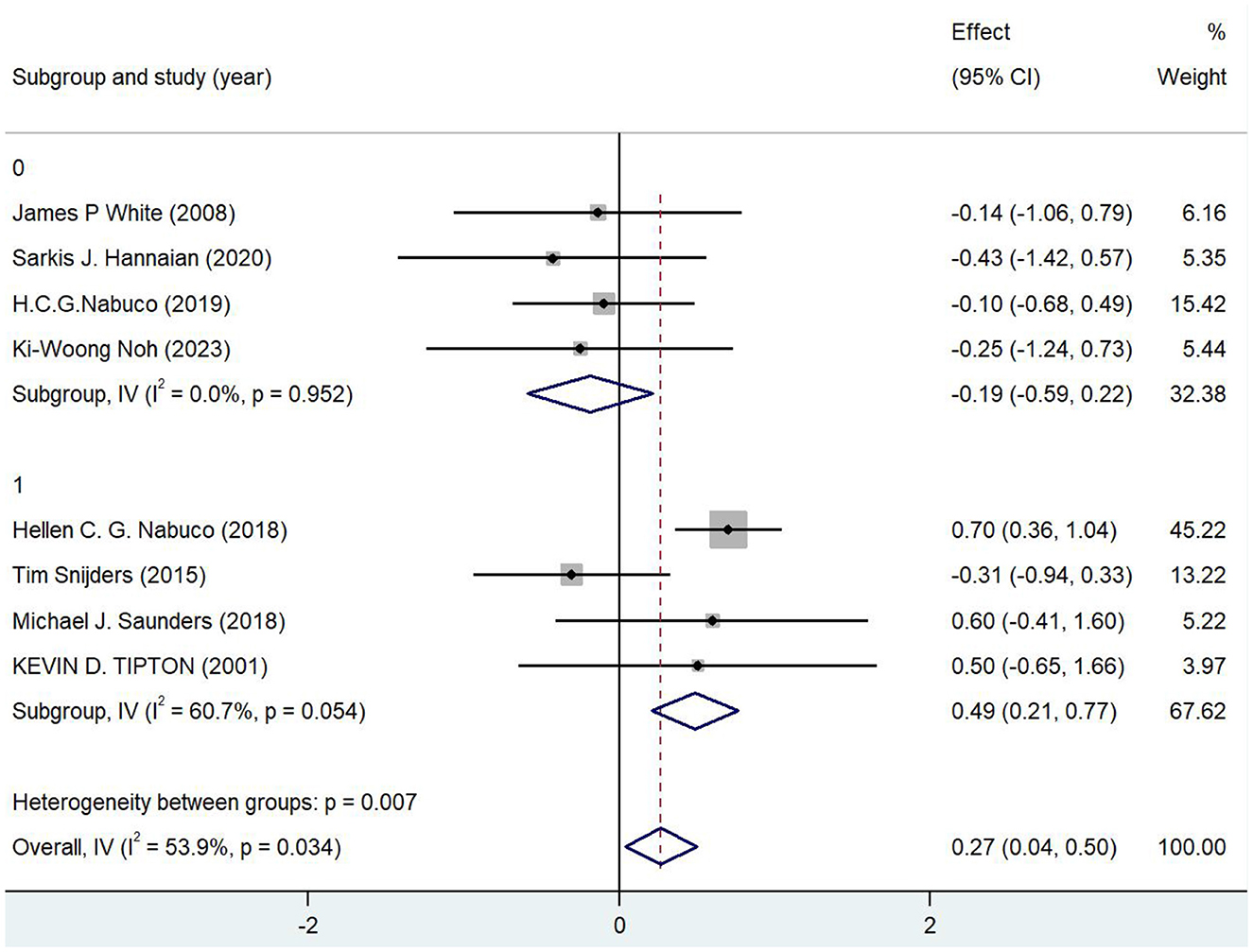- 1School of Sports, Southwest University, Chongqing, China
- 2College of Physical Education and Health, Yili Normal University, Yining, China
- 3College of Artificial Intelligence, Southwest University, Chongqing, China
- 4National and Local Joint Engineering Research Center of Intelligent Transmission and Control Technology, Chongqing, China
- 5College of Physical Education and Health Science, Chongqing Normal University, Chongqing, China
Background: This study used a systematic evaluation and meta-analysis to determine how the timing of nutritional supplements affected the recovery from post-exercise weariness. A vital component of enhancing athletic performance and advancing health is post-exercise recovery, where nutritional supplements are crucial. Although it has been demonstrated that supplementing timing may affect recovery outcomes, there is conflicting evidence about the best time to take supplements.
Methods: We thoroughly searched several academic databases and screened for inclusion of randomized controlled trials, clinical trials, and observational studies that satisfied the criteria in order to examine the effects of varying nutritional supplementation timing (immediate vs. delayed supplementation) on fatigue recovery.
Results: The findings demonstrated that, in comparison to delayed supplementation, protein and carbohydrate supplementation right after exercise dramatically expedited muscle recovery, glycogen recovery, and decreased tiredness. Furthermore, the impact of supplementation timing on recovery effects differed depending on the individual and the type of exercise (e.g., strength training, endurance exercise, and high-intensity interval training).
Conclusion: Recovery from post-exercise weariness is significantly impacted by the timing of nutritional intake. Supplementing with protein and carbohydrates right after exercise, particularly after intense exercise, can help with tiredness relief, muscle recovery, and glycogen replenishment.
1 Introduction
Exercise is crucial for preserving health and enhancing physical fitness (1, 2). Nonetheless, one of the main concerns in exercise science research has been tiredness and its recovery following exercise (3, 4). In addition to reducing sports injuries and easing muscular soreness (5, 6), post-exercise fatigue recovery is a critical component influencing athletes' training efficacy and athletic performance (7, 8). Numerous physiological processes, such as muscle regeneration, energy recovery, immunological modulation, etc., are involved in the fatigue recovery process, and nutritional supplements are a useful means of hastening these processes (9–11). Protein synthesis, glycogen recovery, and hydration are the three key areas where nutritional supplements play a part in workout recovery (12–14). The timing of supplementation has drawn the attention of experts in recent years. The precise effects of immediate vs. delayed post-exercise supplementation on recovery (15–17), results have not been consistently determined (18, 19). As a result, elucidating how the timing of nutritional supplements affects recovery from post-exercise tiredness is not only valuable from an academic standpoint but also serves as a crucial guideline for athletes' recovery and sports training.
This study aims to understand how different timings of nutritional supplements affect recovery from post-exercise fatigue by meticulously examining the existing literature. It will examine the recovery effects of immediate vs. delayed supplementation under various exercise kinds, activity intensities, and participant characteristics. It will concentrate on the effects of protein, carbohydrate, and their combination supplementation. In order to offer a fresh theoretical foundation for further investigation, the physiological mechanisms that underlie the timing of nutritional supplements will also be examined.
2 Materials and methods
2.1 Literature review
2.1.1 The physiological mechanisms of post-exercise fatigue
Muscular microinjuries, energy depletion, and inflammatory reactions are the primary causes of post-exercise fatigue, which is the body's physiological reaction to exercise loads and is characterized by decreased exercise capacity, muscular soreness, and physical weakness (14, 20, 21). Hydration, muscle repair, and glycogen recovery are all part of the recuperation process (22). Protein supplements are necessary to enhance muscle protein synthesis, decrease catabolism, and speed up repair of exercise-induced microdamage to muscle fibers, particularly during strength and aerobic endurance training (23, 24). Significant glycogen depletion occurs during high-intensity exercise; prompt carbohydrate administration can help to quickly replenish glycogen stores and prevent hypoglycemia and extreme exhaustion (25). Exercise causes rapid water loss due to sweating and accelerated breathing; electrolyte and water supplements help restore water balance and avoid weariness and cramping caused by dehydration (26).
2.1.2 The role of nutrition in recovery
Supplementing with nutrients is crucial for the post-exercise recovery phase (27–29). The main ingredient for healing damaged muscles is protein, and taking 10–20 grams of protein supplements after working out will greatly increase muscle protein synthesis (30, 31), help lessen weariness and muscle injury (1, 32, 33). Conversely, carbohydrates aid in the recovery of glycogen, particularly during endurance and high-intensity exercise (34). According to studies, taking a carbohydrate supplement within 30 min of working out greatly speeds up the recovery of glycogen reserves and lessens fatigue (35). Short-term recovery is less affected by fat, but long-term low-intensity exercise recovery benefits from fat supplementation because it preserves bodily homeostasis (36). Supplementing with water and electrolytes is also essential to assist restore lost fluids and minerals during exercise, avoid fluid imbalance, and encourage a full recovery (37). All things considered, a key tactic to encourage quick physical recovery following exercise is the scientific and sensible supplementation of proteins, carbohydrates, fats, water, and electrolytes (38, 39).
2.1.3 Theory of timing for nutritional supplementation
When it comes to when to take nutritional supplements (40), it has long been known that the 30-min period following exercise is the “golden window of recovery,” during which time muscle protein synthesis is at its peak and protein and carbohydrate supplements can hasten recovery (41, 42). According to recent research, supplementation that is delayed may occasionally have a comparable impact, particularly when it comes to low-carb diets. The best time to take supplements may vary depending on the kind, intensity, and individual characteristics of the workout (43, 44).
2.1.4 Previous research and controversies
The effects of immediate vs. delayed post-exercise supplementation appear to vary, according to existing data. According to certain research, taking supplements right after working out speeds up muscle recovery, restores glycogen, and lowers inflammation (34, 45), However, some have argued that the recovery effect is unaffected by delayed supplementation (35, 46), and even lessens discomfort in the stomach. Individual variations in the timing of nutritional supplementation, variations in study design, and variations in sample characteristics are the primary causes of the disagreement surrounding this topic (47).
2.2 Literature selection plan and search strategy
PRISMA (Preferred Reporting Items for Systematic Reviews and Meta-Analyses) standards were applied in this work for data capture and literature scanning in order to conduct a systematic review and meta-analysis (48, 49). Web of Science, PubMed, Cochrane Library, EmBase, and MEDLINE were searched from the library's inception to March 3, 2024, to guarantee that the research material was comprehensive and of high quality. Table 1 lists the inclusion and exclusion criteria that were applied during the literature selection procedure.
2.3 Data extraction process and quality assessment
All literature was independently assessed by two researchers based on inclusion and exclusion criteria, and data extraction in this study followed highly established processes to ensure the reliability and comparability of the results (50). To prevent human bias, two separate researchers conducted the literature screening and data extraction, and the extracted data was double-checked (51). If there were any discrepancies, they were settled through discussion or by getting in touch with the original writers. The following were included in the data extraction: first, documenting the research methods and the type of study design (e.g., clinical trial, cohort study, randomized controlled trial, etc.) (52). The second step involved extracting study sample information, such as the age, gender, health status, exercise experience, kind of exercise (e.g., strength training, endurance exercise, etc.), and sample size of the participants (53). Third, interventions were meticulously documented, including the kind of nutrients provided (proteins, carbohydrates, fats, etc.), the timing of supplementation (shortly after exercise, half an hour later, etc.), and the amount (16, 35, 54). Fourth, information was gathered on important evaluation metrics, such as inflammatory response (C-reactive protein, etc.), fatigue (visual analog scale, fatigue scores), muscle recovery (muscle strength, injury markers), and glycogen recovery (blood glucose levels, muscle glycogen stores) (26, 35). Additionally, statistical techniques including p-values, effect sizes, and confidence intervals were noted. Standardized forms were used to extract all data, and independent reviewers double-checked the results. To guarantee the consistency and accuracy of the data, the research team would get in touch with the original writers to add to and enhance any missing information or unclear passages.
2.4 Statistical analysis
To thoroughly evaluate the overall impact of varying nutritional supplementation timing on post-exercise fatigue recovery, all data analyses in this study were meta-analyzed using a random-effects model. Because they can more precisely evaluate the overall effect and produce more conservative estimates, random-effects models are better suited than fixed-effects models for handling study heterogeneity (55). Because standardized mean differences (SMD) can reduce unit discrepancies among measurement instruments in various research and make cross-study comparisons easier, they were selected as the primary effect sizes. The effect size of the intervention group in comparison to the control group in terms of fatigue recovery, muscle recovery, and other factors is reflected in the SMD number for each study. The I2 statistic was employed to evaluate the heterogeneity among the studies. The degree of diversity between the findings of various research is reflected in the I2 value: a moderate to high level of heterogeneity is indicated by an I2 > 50%, while a low level is indicated by an I2 < 50%. Further sensitivity analyses will be conducted to determine whether there is a meaningful influence on the overall effect by removing studies with high heterogeneity on a case-by-case basis if the I2 value is high (>50%). Furthermore, subgroup analyses can be used to further segment the data based on essential study criteria (e.g., participant group, time of supplementation, kind of exercise, etc.) in order to investigate differences in effects among subgroups when heterogeneity is significant.
3 Results
3.1 Article selection
PRISMA (Figure 1) standards were applied in this work for data capture and literature scanning in order to conduct a systematic review and meta-analysis (56). To guarantee the thoroughness and excellent caliber of the research literature, a multi-database search was carried out.
With a total sample size of 184, 8 (Table 2) studies that satisfied the inclusion criteria were examined. Acute exercise, aerobics, resistance training, and endurance sports were all included in the 270 patients in the sample, 158 of whom were in the experimental group and 112 in the control group.
Three US studies, two Brazilian studies, one Korean study, one Canadian study, and one Dutch study were included in the literature, which was published between 2001 and 2023. Serum creatine kinase levels, muscle protein synthesis and catabolism, muscular pain and recovery, and the impact of whey protein on inflammation and metabolism were among the evaluation criteria. There is less uniformity in the selection of assessment indicators due to the diversity of experimental selection and post-exercise recovery evaluation indicators, which could skew the assessment outcomes.
The research design in supplementation strategy and timing varies greatly, and the time nodes of post-exercise supplementation are inconsistent. A portion of the studies divide supplementation timing into two groups: immediate supplementation and delayed supplementation. Another portion further subdivides supplementation into supplementation at 30 min, 1 h, and 2 h post-exercise, which may also affect the assessment results.
3.2 Meta-analysis and meta-regression results
The timing of nutritional supplements had some positive effects on the major indices of post-exercise fatigue recovery and attained statistical significance, according to the results of the meta-analysis (Table 3) and the forest plot (Figure 2). With a p-value of 0.022 and a 95% CI of [0.039, 0.498], the combined effect value (Overall IV) was 0.269. Overall, the effect was significant (p < 0.05), suggesting that nutritional supplementation improved post-exercise fatigue recovery in a statistically significant way.
A p-value of 0.034 and an I2 of 53.9% indicated a considerable level of study heterogeneity. Heterogeneity may result from variations in the interventions (dosage, time point, kind of supplementation), sample characteristics (gender, age, activity style, etc.), or methods of assessment used in different research.
With the highest study weight (45.22%) and a positive impact value (0.70, 95% CI [0.36, 1.04]), the study by Nabuco et al. (2) appeared to demonstrate that supplementation was useful in enhancing fatigue recovery. Although the effect sizes of the studies by Saunders et al. (34) and Tipton et al. (17) were reasonably large, their CI ranges were wide, and their findings were more unclear. The fact that several of the studies [such Noh et al. (26) and White et al. (46)] had effect values near zero and CI spanning zero indicates that they did not demonstrate a substantial effect.
3.3 Subgroup analysis
Subgroup studies showed (Figure 3) that the timing of nutritional supplementation had a substantial impact on the recovery from post-exercise tiredness. Although there was some heterogeneity (I2 = 53.9%), the overall analysis demonstrated that nutritional supplementation significantly improved fatigue recovery (combined effect value of 0.269, 95% CI [0.039, 0.498], p = 0.022). With no significant effect and no heterogeneity (I2 = 0%), subgroup 0′s combined effect value was −0.186 (95% CI [−0.590, 0.218]), p = 0.366. This suggests that this subgroup might reflect some of the less successful supplementation techniques or less ideal supplementation timing. With a high degree of internal heterogeneity (I2 = 60.7%) and a combined effect value of 0.486 (95% CI [0.207, 0.766]), p = 0.001, subgroup 1 demonstrated a significant positive effect. This suggests that subgroup 1 consists of more effective supplementation strategies, such as timely protein supplementation or particular nutrient combinations after exercise. The significant differences in effects between subgroups are further confirmed by the p-value of 0.007 for the test of heterogeneity between subgroups, highlighting the crucial role that supplements type and timing play in fatigue recovery efficacy. While subgroup 0 may have a weaker effect because of things like later or earlier supplementation timing and ineffective ingredients, subgroup 1′s positive results contributed more to the overall effect (weight of 67.62%), demonstrating the efficacy of timely post-exercise supplementation. In order to improve the results' applicability and generalizability, future research should further optimize supplementation timing points and ingredient selection, as well as thoroughly examine participant characteristics and other potential factors that may influence the effect. Overall, the subgroup analyses emphasized the significance of supplementation timing and strategy.
4 Discussion
4.1 Main findings
According to the study's findings, the timing of nutritional supplements is essential for the recovery from post-exercise weariness (33). Following exercise, immediate supplementation is beneficial for reducing fatigue and enhancing muscular function, particularly when paired with protein and carbohydrates (57). Conversely, delayed supplementation had comparable results to immediate supplementation, particularly in specific groups (such as those following low-carb diets) (52).
The results of this study further support the effect of timing nutritional supplementation on recovery, especially following high-intensity exercise, when compared to previous research. In contrast, Jozo Grgic found that post-exercise supplementation with sodium bicarbonate significantly improved muscular endurance but had no significant energizing effect on muscular strength (53), and Danielle T found no difference between male and female genders when supplementing with branched-chain amino acids (BCAAs) up to 24 h post-exercise (20). These findings demonstrate that delayed supplementation is not less effective than immediate supplementation under certain specific conditions. Individual variances, supplement dosage, activity style, and supplement type may all have a significant impact on this.
4.2 Mechanism exploration
On the one hand, by affecting biology, the impact of replenishment timing on recovery may be realized. The effects of immediate and delayed post-exercise supplementation on muscle repair processes, metabolic control, and neuroprotection can vary. Immediate AKG (α-ketoglutarate) supplementation during high-intensity training facilitates quick entry into the tricarboxylic acid cycle (TCA cycle), aids in amino acid metabolism, and blocks the mTOR pathway, which lowers fatigue and stabilizes blood ammonia levels (58). Neurotrophic factor supplementation that is delayed can decrease pain and inflammatory responses and modify damage receptor sensitivity (e.g., NGF and GDNF) (59).
On the other hand, by affecting physiological processes, the timing of supplementation may have an impact on recovery. Muscle protein synthesis is stimulated and muscle damage is decreased by taking protein supplements right after exercise. Supplementing with carbohydrates on time aids in the quick restoration of glycogen stores and lessens tiredness. Supplementing right after exercise may hasten healing by lowering inflammatory reactions (60).
4.3 Research limitations and future research directions
Some studies did not strictly adhere to the randomized controlled trial design, which could introduce bias; some studies had insufficient data, which impacted the accuracy of the meta-analysis; The results of the combined meta-analysis may have been biased due to the inadequate inclusion of literature on different forms of nutritional supplementation for post-exercise recovery, particularly on the timing of post-exercise nutritional supplementation and sample characteristics; exercise types; Only muscle soreness and recovery, serum creatine kinase levels, muscle protein synthesis and catabolism, and the impact of whey protein on metabolism and inflammation were utilized in this paper due to the large number of post-exercise recovery assessment indicators; these will be examined in greater detail in subsequent research; and supplementation strategies varied among the included studies, which could impact the consistency of the results. Future research could look into how individual characteristics (e.g., training level, dietary habits) and different exercise types and intensities influence when to take supplements. To assess the long-term effects and processes of supplement scheduling, more thorough, long-term clinical trials are required.
5 Conclusions
The timing of dietary intake has a major impact on recovery from post-exercise fatigue. Taking protein and carbohydrate supplements immediately following physical activity, especially vigorous exercise, can aid in muscle healing, glycogen replacement, and fatigue alleviation. For athletes and the broader exercise population, the study described in this paper provides evidence-based recuperation strategies. Future studies should concentrate on figuring out when different persons and activity scenarios benefit from taking supplements.
Author contributions
GC: Conceptualization, Data curation, Funding acquisition, Investigation, Methodology, Resources, Software, Supervision, Writing – original draft, Writing – review & editing. ZZ: Data curation, Investigation, Software, Writing – original draft, Writing – review & editing. ZS: Conceptualization, Data curation, Project administration, Software, Validation, Writing – original draft, Writing – review & editing. YQ: Conceptualization, Data curation, Funding acquisition, Software, Supervision, Visualization, Writing – original draft, Writing – review & editing.
Funding
The author(s) declare that financial support was received for the research and/or publication of this article. This study was funded by the General Project of Chongqing Natural Science Foundation (CSTB2023NSCQ-MSX0698): Construction and Application of a Simulation System for Adolescent Muscle Strength Stability Training.
Conflict of interest
The authors declare that the research was conducted in the absence of any commercial or financial relationships that could be construed as a potential conflict of interest.
Generative AI statement
The author(s) declare that no Gen AI was used in the creation of this manuscript.
Publisher's note
All claims expressed in this article are solely those of the authors and do not necessarily represent those of their affiliated organizations, or those of the publisher, the editors and the reviewers. Any product that may be evaluated in this article, or claim that may be made by its manufacturer, is not guaranteed or endorsed by the publisher.
References
1. Ra SG, Miyazaki T, Ishikura K, Nagayama H, Komine S, Nakata Y, et al. Combined effect of branched-chain amino acids and taurine supplementation on delayed onset muscle soreness and muscle damage in high-intensity eccentric exercise. J Int Soc Sports Nutr. (2013) 10:51. doi: 10.1186/1550-2783-10-51
2. Nabuco HCG, Tomeleri CM, Sugihara Junior P, Fernandes RR, Cavalcante EF, Antunes M, et al. Effects of whey protein supplementation pre- or post-resistance training on muscle mass, muscular strength, and functional capacity in pre-conditioned older women: a randomized clinical trial. Nutrients. (2018) 10:563. doi: 10.3390/nu10050563
3. Chen IF, Wu HJ, Chen CY, Chou KM, Chang CK. Branched-chain amino acids, arginine, citrulline alleviate central fatigue after 3 simulated matches in taekwondo athletes: a randomized controlled trial. J Int Soc Sports Nutr. (2016) 13:28. doi: 10.1186/s12970-016-0140-0
4. Carroll TJ, Taylor JL, Gandevia SC. Recovery of central and peripheral neuromuscular fatigue after exercise. J Appl Physiol. (2017) 122:1068–76. doi: 10.1152/japplphysiol.00775.2016
5. VanDusseldorp TA, Escobar KA, Johnson KE, Stratton MT, Moriarty T, Cole N, et al. Effect of branched-chain amino acid supplementation on recovery following acute eccentric exercise. Nutrients. (2018) 10:1389. doi: 10.3390/nu10101389
6. Bonilla DA, Pérez-Idárraga A, Odriozola-Martínez A, Kreider RB. The 4R's framework of nutritional strategies for post-exercise recovery: a review with emphasis on new generation of carbohydrates. Int J Environ Res Public Health. (2020) 18:103. doi: 10.3390/ijerph18010103
7. Bird SP, Nienhuis M, Biagioli B, De Pauw K, Meeusen R. Supplementation strategies for strength and power athletes: carbohydrate, protein, and amino acid ingestion. Nutrients. (2024) 16:1886. doi: 10.3390/nu16121886
8. Boumosleh JM, El Hage C, Farhat A. Sports nutrition knowledge and perceptions among professional basketball athletes and coaches in Lebanon-a cross-sectional study. BMC Sports Sci Med Rehabil. (2021) 13:53. doi: 10.1186/s13102-021-00280-6
9. Paulsen G, Hamarsland H, Cumming KT, Johansen RE, Hulmi JJ, Børsheim E, et al. Vitamin C and E supplementation alters protein signalling after a strength training session, but not muscle growth during 10 weeks of training. J Physiol. (2014) 592:5391–408. doi: 10.1113/jphysiol.2014.279950
10. Takahashi Y, Matsunaga Y, Tamura Y, Terada S, Hatta H. Pre-exercise high-fat diet for 3 days affects post-exercise skeletal muscle glycogen repletion. J Nutr Sci Vitaminol. (2017) 63:323–30. doi: 10.3177/jnsv.63.323
11. Heaton LE, Davis JK, Rawson ES, Nuccio RP, Witard OC, Stein KW, et al. Selected In-season nutritional strategies to enhance recovery for team sport athletes: a practical overview. Sports Med. (2017) 47:2201–18. doi: 10.1007/s40279-017-0759-2
12. Inacio PAQ, Gomes YSM, de Aguiar AJN, Lopes-Martins PSL, Aimbire F, Leonardo PS, et al. The effects of collagen peptides as a dietary supplement on muscle damage recovery and fatigue responses: an integrative review. Nutrients. (2024) 16:3403. doi: 10.3390/nu16193403
13. Antonio J, Pereira F, Curtis J, Rojas J, Evans C. The top 5 can't-miss sport supplements. Nutrients. (2024) 16:3247. doi: 10.3390/nu16193247
14. Ranchordas MK, Dawson JT, Russell M. Practical nutritional recovery strategies for elite soccer players when limited time separates repeated matches. J Int Soc Sports Nutr. (2017) 14:35. doi: 10.1186/s12970-017-0193-8
15. Cribb PJ, Hayes A. Effects of supplement timing and resistance exercise on skeletal muscle hypertrophy. MedSci Sports Exerc. (2006) 38:1918–25. doi: 10.1249/01.mss.0000233790.08788.3e
16. Nabuco HCG, Tomeleri CM, Sugihara Junior P, Fernandes RR, Cavalcante EF, Venturini D, et al. Effects of pre- or post-exercise whey protein supplementation on body fat and metabolic and inflammatory profile in pre-conditioned older women: a randomized, double-blind, placebo-controlled trial. Nutr Metab Cardiovasc Dis. (2019) 29:290–300. doi: 10.1016/j.numecd.2018.11.007
17. Tipton KD, Rasmussen BB, Miller SL, Wolf SE, Owens-Stovall SK, Petrini BE, et al. Timing of amino acid-carbohydrate ingestion alters anabolic response of muscle to resistance exercise. Am JPhysiol-Endoc M. (2001) 281:E197–206. doi: 10.1152/ajpendo.2001.281.2.E197
18. Areta JL, Burke LM, Ross ML, Camera DM, West DW, Broad EM, et al. Timing and distribution of protein ingestion during prolonged recovery from resistance exercise alters myofibrillar protein synthesis. J Physiol. (2013) 591:2319–31. doi: 10.1113/jphysiol.2012.244897
19. Schweitzer GG, Smith JD, Lecheminant JD. Timing carbohydrate beverage intake during prolonged moderate intensity exercise does not affect cycling performance. Int JExerc Sci. (2009) 2:4–18. doi: 10.70252/QDMJ2907
20. Leahy DT, Pintauro SJ. Branched-chain amino Acid plus glucose supplement reduces exercise-induced delayed onset muscle soreness in college-age females. ISRN Nutr. (2013) 2013:921972. doi: 10.5402/2013/921972
21. O'Connor E, Mündel T, Barnes MJ. Nutritional compounds to improve post-exercise recovery. Nutrients. (2022) 14:5069. doi: 10.3390/nu14235069
22. Roberts J, Zinchenko A, Suckling C, Smith L, Johnstone J, Henselmans M. The short-term effect of high vs. moderate protein intake on recovery after strength training in resistance-trained individuals. J Int Soc Sports Nutr. (2017) 14:44. doi: 10.1186/s12970-017-0201-z
23. James LJ, Stevenson EJ, Rumbold PLS, Hulston CJ. Cow's milk as a post-exercise recovery drink: implications for performance and health. EurJ Sport Sci. (2019) 19:40–8. doi: 10.1080/17461391.2018.1534989
24. Tipton KD. Nutritional support for exercise-induced injuries. Sports Med. (2015) 45 Suppl 1:S93–104. doi: 10.1007/s40279-015-0398-4
25. Kerksick CM, Arent S, Schoenfeld BJ, Stout JR, Campbell B, Wilborn CD, et al. International society of sports nutrition position stand: nutrient timing. J Int Soc Sports Nutr. (2017) 14:33. doi: 10.1186/s12970-017-0189-4
26. Noh KW, Oh JH, Park S. Effects of the timing of carbohydrate intake on metabolism and performance in soccer players. Nutrients. (2023) 15:3610. doi: 10.3390/nu15163610
27. Fernández-Lázaro D, Mielgo-Ayuso J, Del Valle Soto M, Adams DP, Gutiérrez-Abejón E, Seco-Calvo J. Impact of optimal timing of intake of multi-ingredient performance supplements on sports performance, muscular damage, and hormonal behavior across a ten-week training camp in elite cyclists: a randomized clinical trial. Nutrients. (2021) 13:3746. doi: 10.3390/nu13113746
28. Escribano-Ott I, Mielgo-Ayuso J, Calleja-González J. A glimpse of the sports nutrition awareness in Spanish basketball players. Nutrients. (2021) 14:27. doi: 10.3390/nu14010027
29. Grgic J, Pedisic Z, Saunders B, Artioli GG, Schoenfeld BJ, McKenna MJ, et al. International society of sports nutrition position stand: sodium bicarbonate and exercise performance. J Int Soc Sports Nutr. (2021) 18:61. doi: 10.1186/s12970-021-00458-w
30. Thomas DT, Erdman KA, Burke LM. Position of the academy of nutrition and dietetics, dietitians of Canada, and the American College of Sports Medicine: nutrition and athletic performance. JAcad Nutr Diet. (2016) 116:501–28. doi: 10.1016/j.jand.2015.12.006
31. Meeusen R, Duclos M, Foster C, Fry A, Gleeson M, Nieman D, et al. Prevention, diagnosis, and treatment of the overtraining syndrome: joint consensus statement of the European College of Sport Science and the American College of Sports Medicine. MedSci Sports Exerc. (2013) 45:186–205. doi: 10.1080/17461391.2012.730061
32. Areces F, González-Millán C, Salinero JJ, Abian-Vicen J, Lara B, Gallo-Salazar C, et al. Changes in serum free amino acids and muscle fatigue experienced during a half-ironman triathlon. PLoS ONE. (2015) 10:e0138376. doi: 10.1371/journal.pone.0138376
33. Esmarck B, Andersen JL, Olsen S, Richter EA, Mizuno M, Kjaer M. Timing of postexercise protein intake is important for muscle hypertrophy with resistance training in elderly humans. J Physiol. (2001) 535:301–11. doi: 10.1111/j.1469-7793.2001.00301.x
34. Saunders MJ, Luden ND, DeWitt CR, Gross MC, Dillon Rios A. Protein supplementation during or following a marathon run influences post-exercise recovery. Nutrients. (2018) 10:333. doi: 10.3390/nu10030333
35. Mizuno S, Kojima C, Goto K. Timing of carbohydrate ingestion did not affect inflammatory response and exercise performance during prolonged intermittent running. Springerplus. (2016) 5:506. doi: 10.1186/s40064-016-2108-6
36. Rothschild JA, Kilding AE, Plews DJ. What should I eat before exercise? Pre-exercise nutrition and the response to endurance exercise: current prospective and future directions. Nutrients. (2020) 12:3473. doi: 10.3390/nu12113473
37. McCartney D, Desbrow B, Irwin C. Post-exercise ingestion of carbohydrate, protein and water: a systematic review and meta-analysis for effects on subsequent athletic performance. Sports Med. (2018) 48:379–408. doi: 10.1007/s40279-017-0800-5
38. Snijders T, Res PT, Smeets JS, van Vliet S, van Kranenburg J, Maase K, et al. Protein ingestion before sleep increases muscle mass and strength gains during prolonged resistance-type exercise training in healthy young men. JNutr. (2015) 145:1178–84. doi: 10.3945/jn.114.208371
39. Moore DR. Nutrition to support recovery from endurance exercise: optimal carbohydrate and protein replacement. Curr Sports Med Rep. (2015) 14:294–300. doi: 10.1249/JSR.0000000000000180
40. Aragon AA, Schoenfeld BJ. Nutrient timing revisited: is there a post-exercise anabolic window? J Int Soc Sports Nutr. (2013) 10:5. doi: 10.1186/1550-2783-10-5
41. Burke LM, Kiens B, Ivy JL. Carbohydrates and fat for training and recovery. JSports Sci. (2004) 22:15–30. doi: 10.1080/0264041031000140527
42. Levenhagen DK, Gresham JD, Carlson MG, Maron DJ, Borel MJ, Flakoll PJ. Postexercise nutrient intake timing in humans is critical to recovery of leg glucose and protein homeostasis. Am JPhysiol-Endoc M. (2001) 280:E982–93. doi: 10.1152/ajpendo.2001.280.6.E982
43. Wang CC, Lin SC, Hsu SC, Yang MT, Chan KH. Effects of creatine supplementation on muscle strength and optimal individual post-activation potentiation time of the upper body in canoeists. Nutrients. (2017) 9:1169. doi: 10.3390/nu9111169
44. Doherty R, Madigan SM, Nevill A, Warrington G, Ellis JG. The sleep and recovery practices of athletes. Nutrients. (2021) 13:1330. doi: 10.3390/nu13041330
45. Goh Q, Boop CA, Luden ND, Smith AG, Womack CJ, Saunders MJ. Recovery from cycling exercise: effects of carbohydrate and protein beverages. Nutrients. (2012) 4:568–84. doi: 10.3390/nu4070568
46. White JP, Wilson JM, Austin KG, Greer BK, St John N, Panton LB. Effect of carbohydrate-protein supplement timing on acute exercise-induced muscle damage. J Int Soc Sports Nutr. (2008) 5:5. doi: 10.1186/1550-2783-5-5
47. Naclerio F, Larumbe-Zabala E. Effects of whey protein alone or as part of a multi-ingredient formulation on strength, fat-free mass, or lean body mass in resistance-trained individuals: a meta-analysis. Sports Med. (2016) 46:125–37. doi: 10.1007/s40279-015-0403-y
48. Mielgo-Ayuso J, Calleja-Gonzalez J, Marqués-Jiménez D, Caballero-García A, Córdova A, Fernández-Lázaro D. Effects of creatine supplementation on athletic performance in soccer players: a systematic review and meta-analysis. Nutrients. (2019) 11:757. doi: 10.3390/nu11040757
49. Jankaew A, Chen JC, Chamnongkich S, Lin CF. Therapeutic exercises and modalities in athletes with acute hamstring injuries: a systematic review and meta-analysis. Sports Health. (2023) 15:497–511. doi: 10.1177/19417381221118085
50. Schoenfeld BJ, Aragon AA, Krieger JW. The effect of protein timing on muscle strength and hypertrophy: a meta-analysis. J Int Soc Sports Nutr. (2013) 10:53. doi: 10.1186/1550-2783-10-53
51. Viribay A, Burgos J, Fernández-Landa J, Seco-Calvo J, Mielgo-Ayuso J. Effects of arginine supplementation on athletic performance based on energy metabolism: a systematic review and meta-analysis. Nutrients. (2020) 12:1300. doi: 10.3390/nu12051300
52. Hannaian SJ, Orlando MN, Abou Sawan S, Mazzulla M, West DWD, Moore DR. Protein timing does not affect next-day recovery of strength or power but may enhance aerobic adaptations to short-term variable intensity exercise training in recreationally active males: a pilot study. Front Sports Act Living. (2020) 2:568740. doi: 10.3389/fspor.2020.568740
53. Grgic J, Rodriguez RF, Garofolini A, Saunders B, Bishop DJ, Schoenfeld BJ, et al. Effects of sodium bicarbonate supplementation on muscular strength and endurance: a systematic review and meta-analysis. Sports Med. (2020) 50:1361–75. doi: 10.1007/s40279-020-01275-y
54. Lemon PW, Berardi JM, Noreen EE. The role of protein and amino acid supplements in the athlete's diet: does type or timing of ingestion matter? Curr Sports Med Rep. (2002) 1:214–21. doi: 10.1249/00149619-200208000-00005
55. Viribay A, Fernández-Landa J, Castañeda-Babarro A, Collado PS, Fernández-Lázaro D, Mielgo-Ayuso J. Effects of citrulline supplementation on different aerobic exercise performance outcomes: a systematic review and meta-analysis. Nutrients. (2022) 14:3479. doi: 10.3390/nu14173479
56. Liberati A, Altman DG, Tetzlaff J, Mulrow C, Gøtzsche PC, Ioannidis JP, et al. The PRISMA statement for reporting systematic reviews and meta-analyses of studies that evaluate healthcare interventions: explanation and elaboration. BMJ. (2009) 339:b2700. doi: 10.1136/bmj.b2700
57. Cockburn E, Robson-Ansley P, Hayes PR, Stevenson E. Effect of volume of milk consumed on the attenuation of exercise-induced muscle damage. EurJ Appl Physiol. (2012) 112:3187–94. doi: 10.1007/s00421-011-2288-2
58. Tian J, Bao X, Yang F, Tang X, Jiang Q, Li Y, et al. Elevation of intracellular alpha-ketoglutarate levels inhibits osteoclastogenesis by suppressing the NF-κB signaling pathway in a PHD1-dependent Manner. Nutrients. (2023) 15:701. doi: 10.3390/nu15030701
59. Bonini M, Fioretti D, Sargentini V, Del Giacco S, Rinaldi M, Tranquilli C, et al. Increased nerve growth factor serum levels in top athletes. Clin J Sport Med. (2013) 23:228–31. doi: 10.1097/JSM.0b013e31827ee6d5
Keywords: post-exercise fatigue recovery, timing of nutritional supplementation, systematic reviews, meta-analysis, sport
Citation: Cheng G, Zhang Z, Shi Z and Qiu Y (2025) An investigation into how the timing of nutritional supplements affects the recovery from post-exercise fatigue: a systematic review and meta-analysis. Front. Nutr. 12:1567438. doi: 10.3389/fnut.2025.1567438
Received: 27 January 2025; Accepted: 07 April 2025;
Published: 25 April 2025.
Edited by:
Xu Yan, Victoria University, AustraliaReviewed by:
Ana Luz Del Carmen Reyes Ramírez, National Institute of Medical Sciences and Nutrition Salvador Zubirán, MexicoPatrycja Kłósek, Medical University of Silesia, Poland
Copyright © 2025 Cheng, Zhang, Shi and Qiu. This is an open-access article distributed under the terms of the Creative Commons Attribution License (CC BY). The use, distribution or reproduction in other forums is permitted, provided the original author(s) and the copyright owner(s) are credited and that the original publication in this journal is cited, in accordance with accepted academic practice. No use, distribution or reproduction is permitted which does not comply with these terms.
*Correspondence: Yepeng Qiu, cWl1eWVwZW5nQDE2My5jb20=
 Guangxin Cheng
Guangxin Cheng Zhongchen Zhang1,2
Zhongchen Zhang1,2